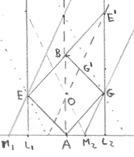-
You can also call this paragraph: Moving clock along a worldline.
- The particle carries a wristwatch and a sparkplug. the sparkplug fires every meter of time (1,2,3,4 ) as read of the particle wristwatch. The laboratory observer notes which of his clocks the travelling particle is near every time the sparkplug fires.
-
As mentioned when you consider the wirstwatch a clock, then this whole text becomes much simpler.
It is the innerworkings of the clock which generates a flash i.e. fires. As such the final result is that the moving clock runs slower as the clock at rest.
Chapter 6. Regions of spacetime
Page 176
- Only light "photons" neutrino's and gravitons can move directly between two events connected by a lightlike interval.
- What is the physical basis behind this claim?
-

Figure 6.3 - Figure 6.3 Two lightlike pairs of Events AE and AG (with event A arbitrarily chosen as reference event) as recorded in spacetime maps of three free float frames.
-
Figure 6.3 shows 3 frames:
- A frame at rest. This frame is identified by the two parallel mirrors L1 and L2. The line in between shows the observer at rest.
- A rocket frame moving towards the right. This frame is identified by the two tilted mirrors M1 and M2.
- A rocket frame moving towards the left. This frame is identified by the two weakly drawn tilted lines.
The Figure also shows that the moving observer does not see the same events simultaneous. She observes the event G at G' (earlier) and the event E at E'(later)
The Figure does not show what the observer moving towards the left observes. In fact it is the reverse as above.
See for comment about the issue of arbitrarily: Reflection 1 - Physics
Reflection 1 - Physics
-
All the 4 exercises Exercise 3-14 Things that move faster than the speed of light are based around physical phenomena. IMO they have nothing to do with SR, specific with the postulates of SR.
- Accordingly to SR this laboratory frame can be any frame. Any frame as such can be called a Rest frame.
- Accordingly to Newton there is only one such a frame. IMO he does not discuss the issue of different frames.
- If you want to understand the total physical reality, IMO it only makes sense to study that using one coordinate system. Ofcourse within that coordinate system you can also local define other coordinate systems, but this has physical no consequences. The main advantage is mathematical.
Figure 6.3 See: 6. Regions of spacetime defines an arbitrarily frame inbetween a frame which has a speed v towards the right and a frame v towards the left. This arbitrarily frame is called the laboratory frame. The physical issue is: where is this frame? Is this the frame centered around my laptop or PC? The center of the earth? Some other free floating frame?
Reflection 2 - How is science performed?
-
How is science being performed? Four principle type of anwers are possible:
- By means of observations and measurements.
- By means of experiments?
- By means of thought experiments or mental experiments.
- BY means of postulates. Postulates are descriptions of physical processes or conditions, accepted as true.
That means experiments come first and based on different experiments the laws of nature can be unraveled.
Feedback
If you want to give a comment you can use the following form Comment form
Created: 22 August 2017
Go Back to Book and Article Review
Back to my home page Index